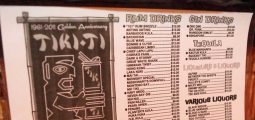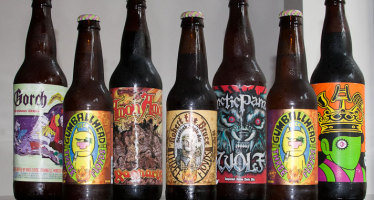Pesach Sameach! (Happy Passover!)

I remember vividly my first Passover Seder. I had been invited by dear friends, Lou and Rose Leviticus, into their home for this special Jewish celebration. It wasn’t terribly unlike many of the other nights I had spent with the couple I fondly referred to as “Grandpa Lou and Grandma Rose”, especially given that Lou and Rose were, as Jews go, more or less secular. And yet the evening, and the meal in particular, took on a special sort of importance that even my dull gentile senses could easily discern. The bite of horseradish, the recitations, and Lou, in his thick Dutch accent that was altered over time from the acquisition of some seven other languages, reading aloud from a sheet of paper he’d printed out – a humble Haggadah, as he dipped his fingers in the Seder cup and flicked wine upon his own neatly varnished hardwood floor. All of it remains in my mind to this day, cherished, and beautiful. I have since brought them passover gifts to say thank you, which they have always loved and which make me feel like I’m contributing in some way.
My wife Sonja and I had our first date on a Thursday night, over a long dinner that ended with sharing a bottle of wine on the back porch of what would eventually become our home. The next night, we attended Good Friday services at the church at which we would eventually marry, and then went to dinner with some of Sonja’s friends. We had no plans to hang out on Saturday night; I had my own plans in fact. But our time together was enjoyable, and in the early stages of romance we couldn’t get enough. My plans that following night included celebrating Passover with other close friends, Gary and Cece (Grandpa Lou and Grandma Rose were, by then, older, and no longer hosted Seders). Not willing to cancel on Gary and Cece, nor on the holiday I had come to love if not yet fully understand, I called Gary Saturday morning.
“Hey, Gary. I’m really looking forward to tonight. So, uh, look, feel free to say ‘no’ here, but I was wondering if there was any way I could bring a guest to your Seder tonight?”
Ever patient with me, Gary replied with a smile I could almost see through the phone: “Mark, it’s Passover! There’s always an extra chair at the Seder table! Bring whomever you like!”
The Seder meal at the home of Gary and Cece Hill was the best third date Sonja and I could have asked for. Surrounded by amazing people, there was a splendid meal and enough energy and uncertainty in what we were doing to keep us distracted from the fact that we were entering the early stages of a relationship. There were nearly twenty people in attendance that evening, all at one great table, and if memory serves, the whole occasion took some five to six hours – time that flew by as we ate, sang, laughed, and enjoyed the company of old friends and new ones alike.
Over the years, Sonja and I haven’t always managed to attend a Seder, though we try, and Passover never takes place without some pleasant reminiscence on our part. Last year, we celebrated Seder at the home of some Jewish friends in Omaha whose son is roughly the same age as ours; sharing it with our children added still more to the experience. In many ways, this Seder was similar to that of Gary and Cece’s, though our understanding of the customs remained incomplete enough to keep us on our toes and guessing. When it came my turn to read from the Maxwell House Haggadah, I underwhelmed everyone with my Hebrew pronunciations, a holdover from my time in theology school, and together with friends, food, and wine, we passed yet another beautiful holiday.
If by now you’ve flipped the magazine over and checked the cover to make sure you’re still reading Food & Spirits, I can assure you, you are. I write about Passover and Seders out of my love for them and admiration for the Jewish faith, yes, but also because they are, to me, the perfect illustration of a point I often make: that wine can be the compliment to a great experience, but rarely should wine be the experience unto itself. Wine is not the centerpiece of a Passover Seder, but like a good steak dinner or a summer evening on the patio, it has an important role to play.
I asked Liz Feldstern, a friend and a Jewish educator based here in Omaha, to help me better understand the role of wine in the Passover Seder. Her response clarified a few points for me, helping me to answer a lot of the “why” questions that had persisted through the years, and which I hadn’t sought answers to during past festivities.
“The centerpiece of the week-long Passover observance is an elaborately structured meal. The purpose of the Passover Seder is to retell (and in some sense re-live) the biblical account of the Hebrew slaves’ deliverance from Egyptian bondage. The number four is a recurring theme at the Seder meal. The educational element of the evening includes asking and answering four basic questions about the uniqueness of the Passover meal, namely, ‘Why is this night different from all other nights?’ One of the many rituals included in the meal is the drinking of four cups of wine at proscribed points in the Seder. All participants are obligated to drink these four cups (although grape juice is also acceptable). The first glass accompanies the opening blessing, the second goes with the telling of the Exodus story, the third is with the grace said after the meal, and the fourth complements the concluding psalms, which, after four glasses of wine, are usually sung pretty spiritedly!”
Liz’s explanation brought back to me many memories, not least the lively singing of Psalms, as well as the telling and retelling of the Exodus story which, from the Christian tradition, was something I was familiar with. Something that has always stood out to me, in fact, is the immense amount of overlap between the Jewish faith and my own. Jesus of course, like all of his disciples, was a Jew, and the “last supper” was most likely a Passover Seder. The connections aren’t at all subtle. In my religious tradition, prayer is central to the faith, and the same is true of Judaism. In fact, there’s even a prayer devoted to wine, recited prior to the drinking of each cup. It reads as follows:
In Hebrew (read from right to left):
???????? ?????? ??????? ?????????? ?????? ???????? ??????? ?????? ???????
Transliterated:
Baruch atah
Adonai, Eloheinu Melech Haolam,
borei p’ri hagafen.
Translated:
Blessed are You,
Adonai our God, Ruler of the universe,
Creator of the fruit of the vine.
While wine is no more a focal point than food or conversation or prayer at most Passover Seders I have attended, it nevertheless plays a central role in the festivities. Children often drink grape juice, and we take turns filling the glasses of those who sit amongst us. It is hard for me to imagine a warmer, more enjoyable evening than sitting around a Seder table with friends, sharing food, conversation, and wine for hours on end.
Though most Jews I know personally celebrate Passover with whatever wine they’ve got around the house or whatever is on sale that week, there are a vast array of Kosher wines, that is, wines that adhere to the laws of Kashrut found in the Torah. They aren’t easy to find in Omaha, but easy enough to order online. Israel also has a booming wine industry, and is making some truly terrific stuff.
On occasion, a friend has questioned me about my enthusiasm for a Jewish holiday, given that I am a Christian. Of course, there is the substantial overlap between the faiths that I mentioned before, but perhaps even more importantly, there’s nothing more spiritual in my eyes than fellowship, no experience greater than sharing time with people you love and enjoy talking to. And if that shared experience happens to dictate that it come with four cups of wine, well then, even better!
L’Chaim!

Mark Gudgel
Dr. Mark Gudgel is a wine writer and educator who holds credentials through the Wine & Spirit Education Trust (WSET) and is working towards becoming a Master of Wine. His interest in wine was sparked on his honeymoon to Napa and Sonoma. Gudgel and his wife, Sonja, have co-authored several articles as well as a book on the wineries of Nebraska, to be released in the spring of 2017. Gudgel is a regular contributor to Food & Spirits Magazine and American Winery Guide, as well as the blog he maintains with his wife, www.itheewine.com. Mark and Sonja live in Omaha with their children and their dog.
Related Articles
Beer Chat: Magical Moments with Beer
Even on its own, beer is a magical thing. The best beer moments happen when the company, circumstances and environment
Beer Chat: Magical moments with beer
There are many correlations between the creation of visual art and craft beer. The artist starts with a blank canvas
Is Bigger Better?
We are Americans. We like big things—big cars, big houses, big food portions, big shopping malls with big stores in
No comments
Write a commentOnly registered users can comment.














